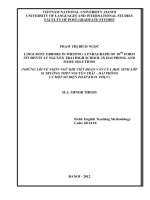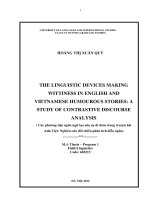apologizing strategies by american speakers of english and vietnamese speakers of english chiến lược xin lỗi bằng ngôn ngữ anh của người mĩ và người việt
Bạn đang xem bản rút gọn của tài liệu. Xem và tải ngay bản đầy đủ của tài liệu tại đây (489.62 KB, 5 trang )
VIETNAM NATIONAL UNIVERSITY, HANOI
UNIVERSITY OF LANGUAGES AND INTERNATIONAL STUDIES
FACULTY OF POST-GRADUATE STUDES
NGUYỄN THÙY TRANG
APOLOGIZING STRATEGIES BY AMERICAN SPEAKERS OF ENGLISH
AND VIETNAMESE SPEAKERS OF ENGLISH
CHIẾN LƯỢC XIN LỖI BẰNG NGÔN NGỮ ANH CỦA NGƯỜI MĨ VÀ NGƯỜI VIỆT
M.A. COMBINED PROGRAM THESIS
HÀ NỘI, 2010
Field: English Linguistics
Code: 60 22 15
Supervisor: Phan Thị Vân Quyên, M.A
iv
TABLE OF CONTENTS
CERTIFICATE OF ORIGINALITY OF PROJECT REPORT ……………………
i
ACKNOWLEDGEMENTS ……………………………………………………….
ii
ABSTRACT ……………………………………………………………………….
iii
TABLE OF CONTENTS ………………………………………………………….
iv
LIST OF ABBREVIATIONS AND CONVENTIONS ……………………………
vi
LIST OF TABLES …………………………………………………………………
vii
PART A: INTRODUCTION
1. Problem statement and background ……………………………………….
1
2. Aims of the study …………………………………………………………….
2
3. Scope of the study ……………………………………………………………
3
4. Methods of the study …………………………………………………………
3
5. The organization of the study ……………………………………………….
4
PART B: DEVELOPMENT
Chapter 1: LITERATURE REVIEW
1.1. Cross-cultural communication
1.1.1. Cross-cultural communication ……………………………………
5
1.1.2. Potential problems in Vietnamese-American cross-cultural
communication …………………………………………………….
7
1.2. Speech acts theories
1.2.1. Speech acts …………………………………………………………
9
1.2.2. Three – dimension speech act ……………………………………
10
1.2.3. Classification of speech act ………………………………………
11
1.2.4. Apologizing as a speech act ………………………………………
12
1.3. Politeness
1.3.1. Politeness theories …………………………………………………
15
1.3.2. Politeness in apologizing ………………………………………….
18
1.4. Situations which elicit apologies in American culture and Vietnamese
culture ………………………………………………………………………
19
1.5. Apologizing strategies ……………………………………………………
20
1.6. Previous studies on apologizing …………………………………………
26
Chapter 2: METHODOLOGY
2.1. Research methods ……………………………………………………………
32
v
2.2. Data collection instruments …………………………………………………
33
2.3. The questionnaire ……………………………………………………………
34
2.3.1. Factors manipulated in the DCT ………………………………………
35
2.3.2. The DCT ………………………………………………………………
34
2.4. The subjects …………………………………………………………………
39
2.5. Data collection and analysis procedure …………………………………….
41
Chapter 3: FINDINGS AND DISCUSSION
3.1. Overview of the apologizing strategies used by two groups of subjects …
43
3.2. Choices of apologizing strategies by situations ……………………………
50
3.2.1. Choices of strategies by Vietnamese speakers of English …………….
50
3.2.2. Choices of strategies by American speakers of English ………………
52
3.2.3. A comparison of the strategies preferences by two groups of subjects
53
3.3. Preferences of apologizing strategies as seen from communicating
partner’s parameters ………………………………………………………………
58
3.3.1. Vietnamese’s apologizing strategies as seen from communicating
partner’s parameters …………………………………………………………………
58
3.3.2. American’s apologizing strategies as seen from communicating
partner’s parameters …………………………………………………………………
60
3.3.3. A comparison of Vietnamese and American subjects’ apologizing
strategies as seen from communicating partner’s parameters ………………………
62
PART C: CONCLUSION AND IMPLICATIONS
1. Conclusion …………………………………………………………………….
67
2. Implications for cross-cultural communication and TEFL in Vietnam ……
69
3. Limitations of the study and suggestions for further study …………………
70
BIBLIOGRAPHY
72
APPENDICES
Appendix A: Discourse Completion Task (for American subjects) (DCT) ……
Appendix B: Discourse Completion Task (for Vietnamese subjects) (DCT) …
Appendix C: The coding system ………………………………………………
Appendix D: Sample Coding Scheme of a DCT ………………………………
I
IV
VII
IX
iii
ABSTRACT
The study “Apologizing strategies by American speakers of English and Vietnamese
speakers of English” is a cross-cultural pragmatics one concerning the production of
apology with reference to strategy preferences done via a written DCT and analyzed for
sociocultural features. Seventy-six informants equally falling into two main groups,
American speakers of English and Vietnamese speakers of English, were invited to
participate in the survey from which the apologizing verbal expressions towards different
communicating partners in four studied situations would be elicited. The exhaustive
framework of apology strategies proposed by Cohen and Olshtain (1989) and Trosborg
(1995) were the foundation for this study whose findings have revealed noticeable
coincidences. Firstly, Vietnamese speakers of English and American speakers of English
both employed a same high level of using the strategy Explicit expression of apology
combining with Acknowledgment of responsibility and Explanation for the violation when
apologizing. It was however interesting that while the American subjects mainly chose the
strategy Offer of repair to apologize, the Vietnamese ones preferred to show Concern for
the hearer sharpening the images of the cultural traits of a sentimental Vietnamese culture
and a rational American culture. The Vietnamese’s apology realizations from this study
moreover reflect the more power and distance-sensitivity towards the selection of
apologizing strategies than the American groups, which has cemented the theories of
Brown and Levinson (1983), Trosborg (1989) and many other previous studies on the
influential factors of the speech act realization.
The accomplishment of the thesis is hoped to serve as a useful source of reference for
researchers in related fields, Vietnamese teachers and learners of English as well as those
with regular Vietnamese – American cross-cultural contacts. Important findings have also
cemented the inevitability of incorporating culture into the teaching of English so that
Vietnamese learners of English will be provided with both linguistic and cultural input
PDF Merger
Thank you for evaluating AnyBizSoft PDF
Merger! To remove this page, please
register your program!
Go to Purchase Now>>
Merge multiple PDF files into one
Select page range of PDF to merge
Select specific page(s) to merge
Extract page(s) from different PDF
files and merge into one
AnyBizSoft









